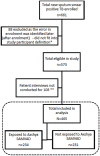Patient characteristics, health seeking and delays among new sputum smear positive TB patients identified through active case finding when compared to passive case finding in India
- PMID: 30865730
- PMCID: PMC6415860
- DOI: 10.1371/journal.pone.0213345
Patient characteristics, health seeking and delays among new sputum smear positive TB patients identified through active case finding when compared to passive case finding in India
Abstract
Background: Axshya SAMVAD is an active tuberculosis (TB) case finding (ACF) strategy under project Axshya (Axshya meaning 'free of TB' and SAMVAD meaning 'conversation') among marginalized and vulnerable populations in 285 districts of India.
Objectives: To compare patient characteristics, health seeking, delays in diagnosis and treatment initiation among new sputum smear positive TB patients detected through ACF and passive case finding (PCF) under the national TB programme in marginalized and vulnerable populations between March 2016 and February 2017.
Methods: This observational analytic study was conducted in 18 randomly sampled Axshya districts. We enrolled all TB patients detected through ACF and an equal number of randomly selected patients detected through PCF in the same settings. Data on patient characteristics, health seeking and delays were collected through record review and patient interviews (at their residence). Delays included patient level delay (from eligibility for sputum examination to first contact with any health care provider (HCP)), health system level diagnosis delay (from contact with first HCP to TB diagnosis) and treatment initiation delays (from diagnosis to treatment initiation). Total delay was the sum of patient level, health system level diagnosis delay and treatment initiation delays.
Results: We included 234 ACF-diagnosed and 231 PCF-diagnosed patients. When compared to PCF, ACF patients were relatively older (≥65 years, 14% versus 8%, p = 0.041), had no formal education (57% versus 36%, p<0.001), had lower monthly income per capita (median 13.1 versus 15.7 USD, p = 0.014), were more likely from rural areas (92% versus 81%, p<0.002) and residing far away from the sputum microscopy centres (more than 15 km, 24% versus 18%, p = 0.126). Fewer patients had history of significant loss of weight (68% versus 78%, p = 0.011) and sputum grade of 3+ (15% versus 21%, p = 0.060). Compared to PCF, HCP visits among ACF patients was significantly lower (median one versus two HCPs, p<0.001). ACF patients had significantly lower health system level diagnosis delay (median five versus 19 days, p = 0.008) and the association remained significant after adjusting for potential confounders. Patient level and total delays were not significantly different.
Conclusion: Axshya SAMVAD linked the most impoverished communities to TB care and resulted in reduction of health system level diagnosis delay.
Conflict of interest statement
The authors have declared that no competing interests exist.
Figures



Similar articles
-
Active versus passive case finding for tuberculosis in marginalised and vulnerable populations in India: comparison of treatment outcomes.Glob Health Action. 2019;12(1):1656451. doi: 10.1080/16549716.2019.1656451. Glob Health Action. 2019. PMID: 31475635 Free PMC article.
-
Active case finding among marginalised and vulnerable populations reduces catastrophic costs due to tuberculosis diagnosis.Glob Health Action. 2018;11(1):1494897. doi: 10.1080/16549716.2018.1494897. Glob Health Action. 2018. PMID: 30173603 Free PMC article.
-
Role of community-based active case finding in screening tuberculosis in Yunnan province of China.Infect Dis Poverty. 2019 Oct 29;8(1):92. doi: 10.1186/s40249-019-0602-0. Infect Dis Poverty. 2019. PMID: 31661031 Free PMC article.
-
Active case-finding for tuberculosis in India.Natl Med J India. 2019 Mar-Apr;32(2):90-95. doi: 10.4103/0970-258X.275349. Natl Med J India. 2019. PMID: 31939405 Review.
-
Active Case Finding for Tuberculosis in India: A Syntheses of Activities and Outcomes Reported by the National Tuberculosis Elimination Programme.Trop Med Infect Dis. 2021 Nov 30;6(4):206. doi: 10.3390/tropicalmed6040206. Trop Med Infect Dis. 2021. PMID: 34941662 Free PMC article. Review.
Cited by
-
Barriers to engagement in the care cascade for tuberculosis disease in India: A systematic review of quantitative studies.PLoS Med. 2024 May 28;21(5):e1004409. doi: 10.1371/journal.pmed.1004409. eCollection 2024 May. PLoS Med. 2024. PMID: 38805509 Free PMC article.
-
Pooled testing of sputum with Xpert MTB/RIF and Xpert Ultra during tuberculosis active case finding campaigns in Lao People's Democratic Republic.BMJ Glob Health. 2022 Feb;7(2):e007592. doi: 10.1136/bmjgh-2021-007592. BMJ Glob Health. 2022. PMID: 35165095 Free PMC article.
-
Male Sex Bias in Immune Biomarkers for Tuberculosis.Front Immunol. 2021 Mar 16;12:640903. doi: 10.3389/fimmu.2021.640903. eCollection 2021. Front Immunol. 2021. PMID: 33796106 Free PMC article.
-
Impact of Advocacy, Communication, Social Mobilization and Active Case Finding on TB Notification in Jharkhand, India.J Epidemiol Glob Health. 2019 Dec;9(4):233-242. doi: 10.2991/jegh.k.190812.002. J Epidemiol Glob Health. 2019. PMID: 31854164 Free PMC article.
-
Delay in the diagnosis of pulmonary tuberculosis in The Gambia, West Africa: A cross-sectional study.Int J Infect Dis. 2020 Dec;101:102-106. doi: 10.1016/j.ijid.2020.09.029. Epub 2020 Sep 16. Int J Infect Dis. 2020. PMID: 32949776 Free PMC article.
References
-
- World Health Organization (WHO). Global tuberculosis report 2018. Geneva, Switzerland; 2018.
-
- World Health Organization (WHO). Global strategy and targets for tuberculosis prevention, care and control after 2015. Geneva Switzerland; 2013.
-
- World Health Organization (WHO). End TB Strategy. WHO/HTM/TB/2015.19. Geneva, Switzerland; 2015.
Publication types
MeSH terms
LinkOut - more resources
Full Text Sources
Miscellaneous

